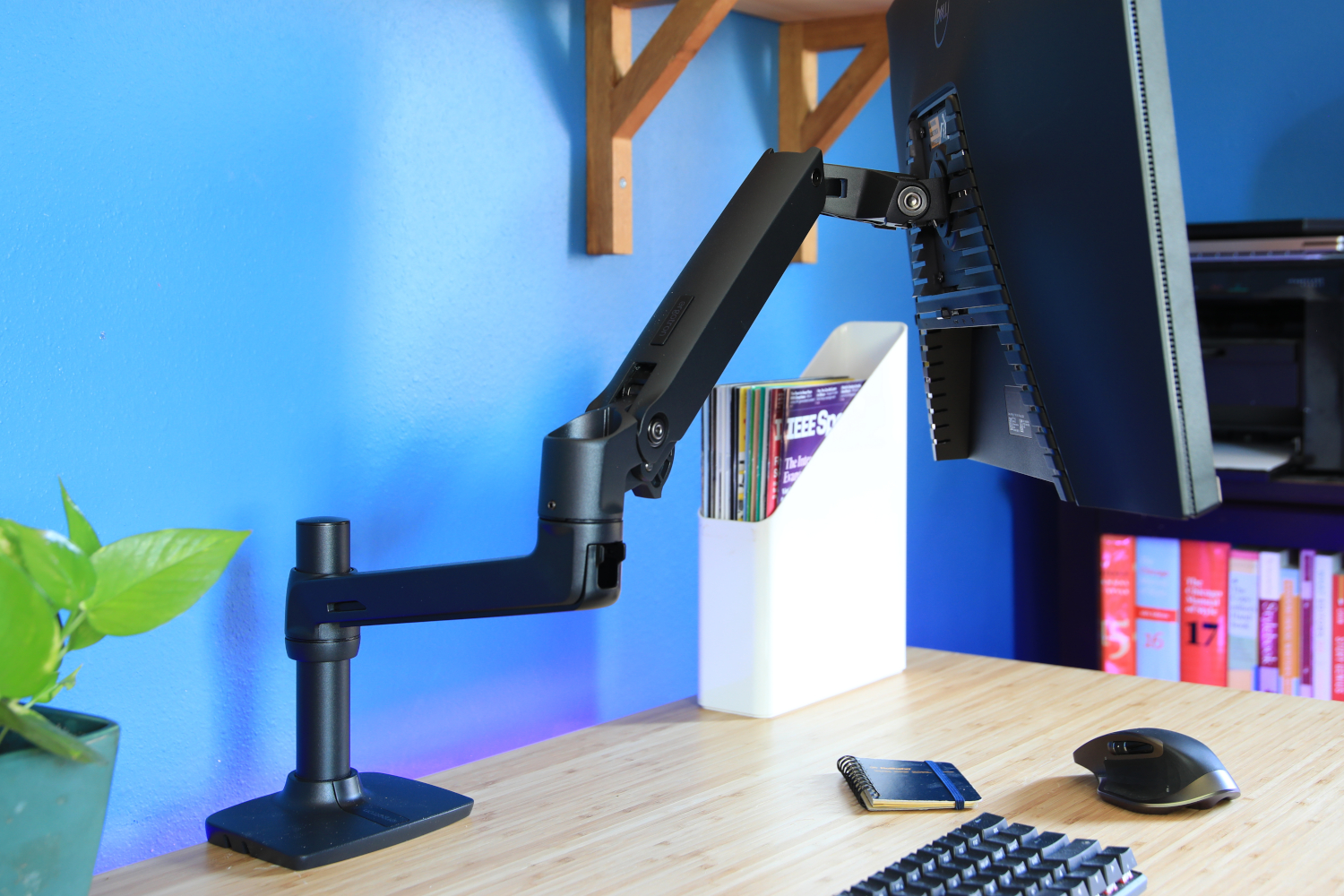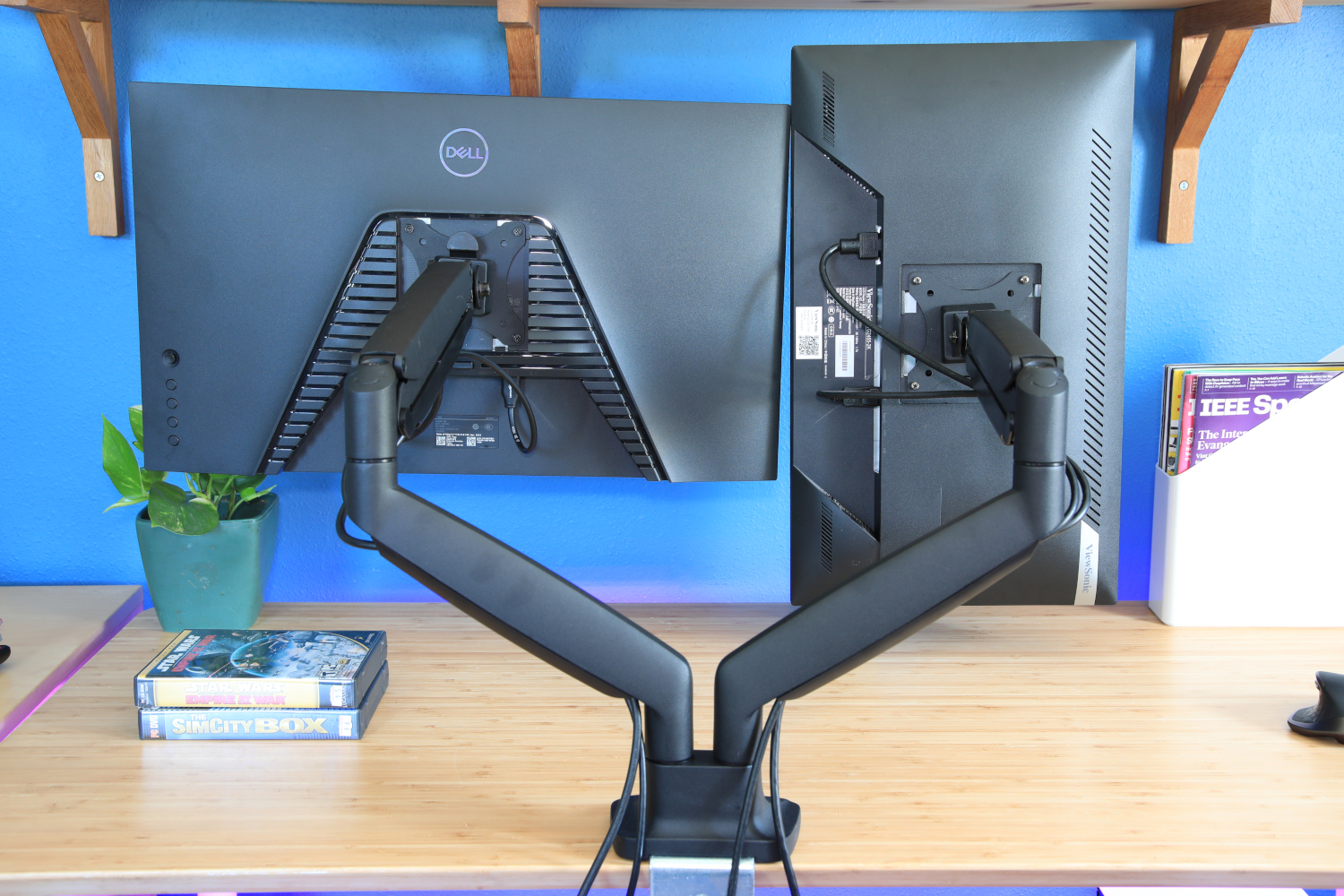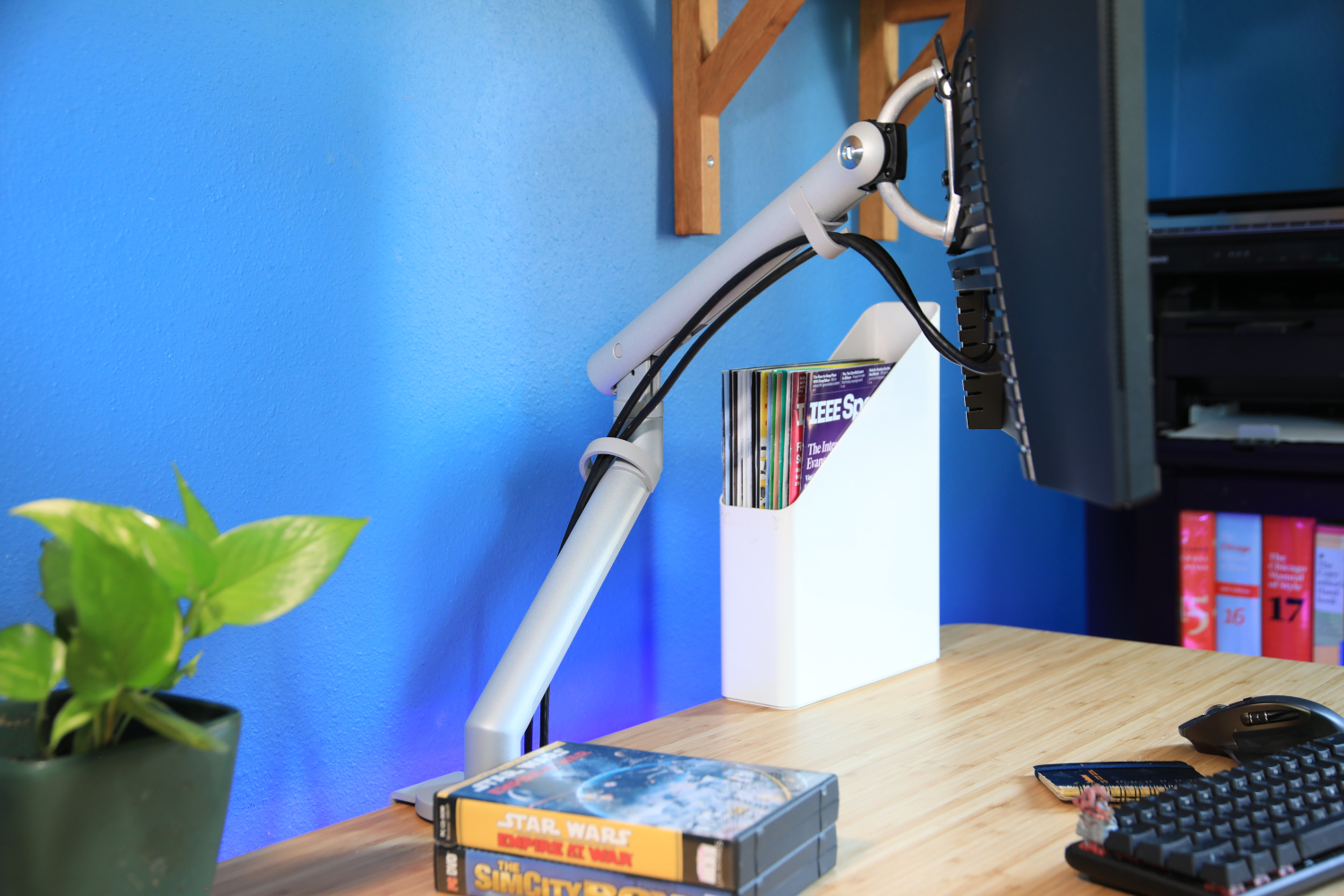A monitor arm is a device that attaches to your desk or wall and allows you to adjust the height, angle, and position of your monitor. Most monitor arms support one monitor, but some support two or more. An arm is usually a replacement for a stand. Most monitors don’t ship with an arm included, so you’ll have to buy it separately.
This raises the question: Is a monitor arm worth it? Yes, absolutely. Monitor arms have many positives and nearly zero downsides.
Monitor arms are comfortable
Let’s start with the obvious. Monitor arms provide a huge range of adjustment for height, tilt, and swivel, and many can pivot a display 90 degrees into portrait orientation.
The exact range of adjustment differs, with more expensive arms usually offering a wider range, but most greatly exceed the adjustment available from a stand. Monitor stands usually have 5 to 6 inches of height adjustment, for example, but arms usually have 10 to 15 inches.
All of this makes your monitor more comfortable to use, since you can position the monitor at the precise distance and height you prefer. A quality monitor arm like PC World’s top pick, the Ergotron LX, will also take less effort to adjust than a stand.
Personally, I find regular adjustments helpful for my neck stiffness, which creeps in when I spend more than an hour viewing a monitor from the same position. I use a monitor arm every day and wouldn’t want to go without.
Monitor arms are perfect for multi-monitor workstations
A monitor arm is nearly mandatory for a multi-monitor workstation. While it’s possible to use different monitors with their own stands, it’s difficult to align them because of differences in the height and size of each stand. Some arrangements, like two monitors stacked vertically, are impossible without an arm.
While it’s often fine to attach each monitor to its own monitor arm, the best solution is an arm that combines two or three monitor arms into one piece of hardware. These multi-monitor arms offer a huge range of adjustment but mount at a single point on your desk.
The Workstream by Monoprice Dual Monitor Arm and Ergotron LX Dual Monitor Arm are great examples of this. Both support two monitors yet mount and function exactly like their single-arm siblings.
Computer monitors are larger than ever before. You can pick from dozens of 34-inch, 45-inch, and 49-inch ultrawide monitors, as well as 40-inch and 42-inch widescreen displays. These massive displays also ship with gigantic, desk-consuming stands that leave little space for a keyboard, a docked laptop, a decorative plant, and anything else you want on your desk.
A monitor arm fixes that problem entirely. Most monitor arms, even those meant to support huge displays, mount to either the rear of a desk or to a grommet mount (if your desk supports that). The mount is usually less than six inches wide and just a couple inches tall, leaving most of your desktop free for use.
The Herman Miller Flo, our favorite “upscale” monitor arm, is especially slender. It has a tiny circular mount that measures about three inches in diameter yet delivers about 20 inches of depth adjustment and 13 inches of height. The arm also folds to sit the monitor flush with the rear of your desk. In that position, you can use your entire desk as if you don’t have a monitor at all.
Not in daily use. A monitor arm offers a wider range of adjustment than a stand, is easier to adjust than a stand, and takes up less space than a stand.
But you will find two obstacles: price and installation.
Trending for you

The Workstream by Monoprice Monitor Arm, our budget pick, is typically $60, and prices go up quickly from there. The Ergotron LX is $150 to $200; the Herman Miller Flo is often $250 or more. That’s not an unreasonable expense but can seem tough to justify if you only spent a couple hundred bucks on your monitor.
Monitor arms also require installation. You’ll need to move your desk out from your wall, slide under it, and fiddle with an Allen wrench. It’s not rocket science, but it’s a hassle. Large monitor arms, like dual-monitor arms, might require two people to set up (one to install the mount while the other holds the arms in a fixed position).
Monitor arms are worth the investment
The price and installation of a monitor arm might seem intimidating but make no mistake: A monitor arm is worth it. A monitor arm is superior to a stand in every situation. A quality arm is durable, too, so it can easily last for a decade or more. This is hardware you’ll use all day, every day.
All of this makes your monitor more comfortable to use, since you can position the monitor at the precise distance and height you prefer. A quality monitor arm like PC World’s top pick, the Ergotron LX, will also take less effort to adjust than a stand.
Personally, I find regular adjustments helpful for my neck stiffness, which creeps in when I spend more than an hour viewing a monitor from the same position. I use a monitor arm every day and wouldn’t want to go without.
Monitor arms are perfect for multi-monitor workstations
A monitor arm is nearly mandatory for a multi-monitor workstation. While it’s possible to use different monitors with their own stands, it’s difficult to align them because of differences in the height and size of each stand. Some arrangements, like two monitors stacked vertically, are impossible without an arm.
While it’s often fine to attach each monitor to its own monitor arm, the best solution is an arm that combines two or three monitor arms into one piece of hardware. These multi-monitor arms offer a huge range of adjustment but mount at a single point on your desk.
The Workstream by Monoprice Dual Monitor Arm and Ergotron LX Dual Monitor Arm are great examples of this. Both support two monitors yet mount and function exactly like their single-arm siblings.
Computer monitors are larger than ever before. You can pick from dozens of 34-inch, 45-inch, and 49-inch ultrawide monitors, as well as 40-inch and 42-inch widescreen displays. These massive displays also ship with gigantic, desk-consuming stands that leave little space for a keyboard, a docked laptop, a decorative plant, and anything else you want on your desk.
A monitor arm fixes that problem entirely. Most monitor arms, even those meant to support huge displays, mount to either the rear of a desk or to a grommet mount (if your desk supports that). The mount is usually less than six inches wide and just a couple inches tall, leaving most of your desktop free for use.
The Herman Miller Flo, our favorite “upscale” monitor arm, is especially slender. It has a tiny circular mount that measures about three inches in diameter yet delivers about 20 inches of depth adjustment and 13 inches of height. The arm also folds to sit the monitor flush with the rear of your desk. In that position, you can use your entire desk as if you don’t have a monitor at all.
Not in daily use. A monitor arm offers a wider range of adjustment than a stand, is easier to adjust than a stand, and takes up less space than a stand.
But you will find two obstacles: price and installation.
Trending for you

The Workstream by Monoprice Monitor Arm, our budget pick, is typically $60, and prices go up quickly from there. The Ergotron LX is $150 to $200; the Herman Miller Flo is often $250 or more. That’s not an unreasonable expense but can seem tough to justify if you only spent a couple hundred bucks on your monitor.
Monitor arms also require installation. You’ll need to move your desk out from your wall, slide under it, and fiddle with an Allen wrench. It’s not rocket science, but it’s a hassle. Large monitor arms, like dual-monitor arms, might require two people to set up (one to install the mount while the other holds the arms in a fixed position).
Monitor arms are worth the investment
The price and installation of a monitor arm might seem intimidating but make no mistake: A monitor arm is worth it. A monitor arm is superior to a stand in every situation. A quality arm is durable, too, so it can easily last for a decade or more. This is hardware you’ll use all day, every day.







